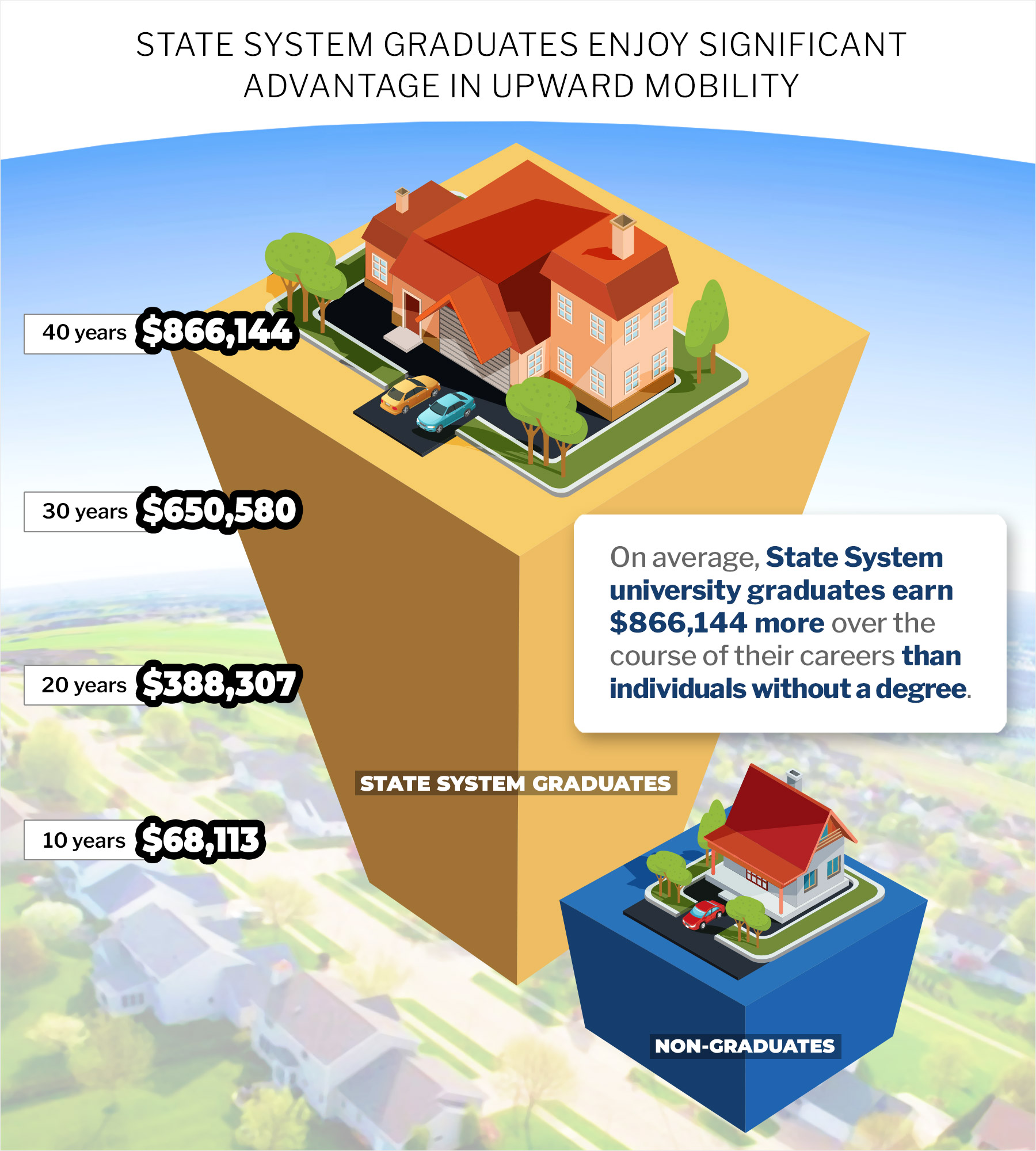2021-22 Monthly Themes
Each month of the #Together4PASSHE Advocacy Campaign, we will share messages and data around an important theme that helps promote the impact and value of a State System Education. Use your social networks to share these messages, data, and your own stories with state legislators.
October 2021: Contributions to the State
Monthly Messages
State System universities are catalysts for upward social mobility for the whole community, and especially for those underrepresented populations that face social and economic barriers to success.
While State System universities not only provide a personal benefit to their students,
they also represent a public good that has a multiplier effect for their community
and for the Commonwealth.
Supporting Data
- Total economic impact of the State System on the Commonwealth during FY 19-20 was $4.0 billion
- Each dollar invested by the Commonwealth to one State System university produced an average return of $8.30 in economic impact
- Aggregate result of total direct spending in 2022-23 is expected to support approximately 45,940 jobs within the Commonwealth, in addition to the State System employees
- Direct spending from FY 2013-14 to FY 2019-20 increased by 2.9 percent
- Projected economic impact of the State System during FY 2022-23 is $3.8 billion, excluding impact from capital expenditures
- Total impact of Institutional spending projected to increase by 7.6 percent over the period of FY 2019-20 to 2022-23
System Success | Contributions to the State
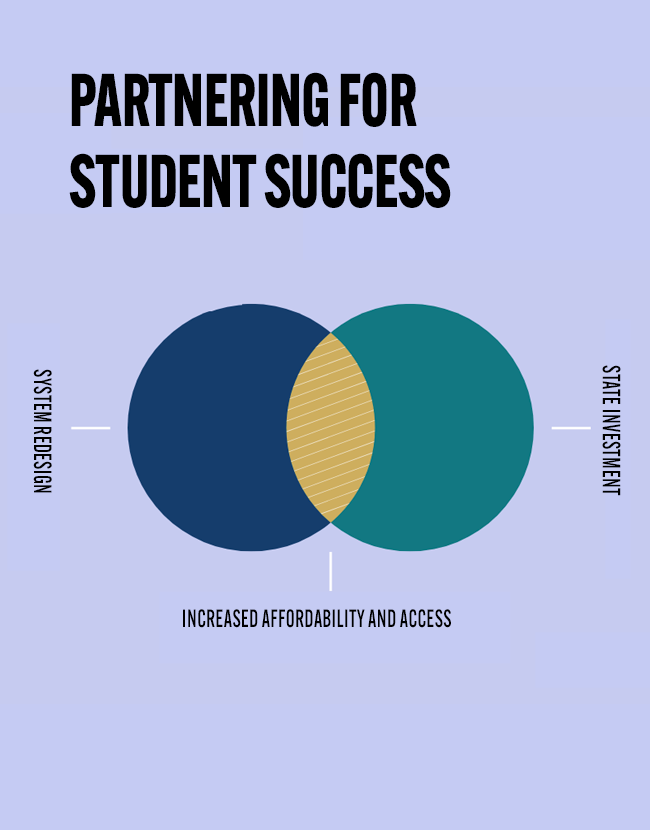
November 2021: Student Affordability
The State System’s mission is to provide the most affordable, high quality education
possible. Unfortunately, a State System education is drifting beyond the reach of
the students we were born to serve. Here’s how much and why costs have increased:
- Over the last decade, the average price students pay to attend a State System university has increased by 33%.
- The proportion of education costs paid by students at 4-year public institutions in Pennsylvania was 71.9% in 2020, ranking Pennsylvania as the 11th highest in the country for percentage of costs borne by students.
- For low- and middle-income families (income less than $110,000), almost 40 cents of every dollar earned goes to paying for a State System education, compared to just 20 cents of every dollar for high-income families.
- The proportion of enrolled students from lower- and middle-income families has declined from 80% in 2011 to 70% in 2019.
- Although Pennsylvania has increased funding for public education in recent years,
and federal relief funding has been helpful, the State System’s current state funding,
when adjusted for inflation, is only between FY 2010-11 and FY 2011-12 levels.
Supporting messages
- A student’s share of cost may continue to rise substantially absent significant recurring state investment.
- State investment can reduce the share of low and middle-income students’ cost of a State System education; an additional $1,000 per student increases retention by 3-4% and also supports increased recruitment and graduation.
- State support is crucial if the State System is to recapture its affordability advantage and bring down costs for State System students.
- The State System’s FY 2022-23 appropriation request of $550 million and at least $201 million in direct funds to students will have measurable benefits including:
- providing a high-quality education at the lowest possible price for those who can least afford it,
- reducing the financial burden on students and their families,
- ensuring students have the resources necessary to complete their degree, and
- improving pathways for community college and nontraditional students to advance toward a bachelor’s degree.
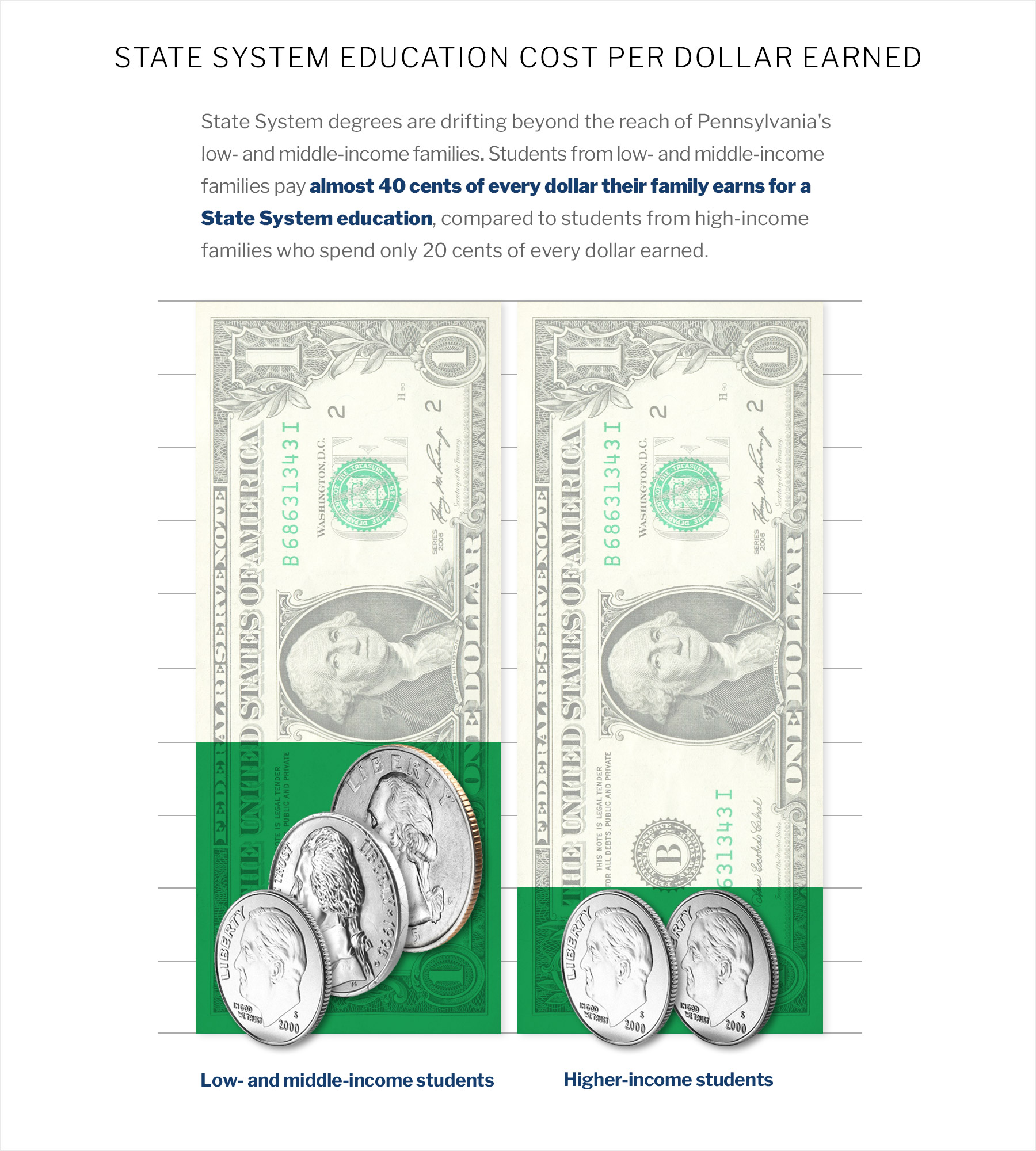
December 2021: Student Progression and Completion
State System universities know what works to motivate students to successfully navigate
their college experience. From emergency financial aid to wraparound student support
services and more, university practices help State System students stay in college
and complete their degrees at rates that consistently outperform similar institutions.
And community college transfer students outperform students who enrolled directly
from high school. In the coming decade though, a growing number of jobs within the
state will require a bachelor’s degree. To tackle this challenge, bold investment
in the System is the surest way to enhance support for students and staff, help drive
completion, and meet the state’s educational attainment goals.
- For the 2020-21 academic year, State System universities conferred nearly 24,000 degrees and certificates in high-demand areas like STEM, health, business, and education. Over 760,000 degrees and certificates have been conferred since the inception of the System in 1983.
- As a result of Systemwide goal alignment and comprehensive planning, the State System consistently outperforms national 4-year public institutions with State System 2nd year retention at about 79%.
- State System 6-year graduation rates are also higher than the national 4-year public institution, averaging 60% compared to 51%.
- The average federal student loan 3-year cohort default rate for State System students is currently 5.8% compared to the national public 4-year at 5.4% with the national 4-year at 7.3%.
- On average, first-time State System students are covering almost 40% of their annual costs (tuition, fees, room, and board) through student loans (federal and private loans).
- Students transferring into a State System university from a Pennsylvania community college continues to be 12% of the new student population even during declining enrollment.
- Transfer students persist at State System universities at a higher rate than non-transfer
students. In Fall 2021, the second-year persistence rate for transfer students was
5.2 percentage points higher than for non-transfers.
Supporting messages
- Pennsylvania is experiencing a chronic and severe “talent gap” that is starving employers of the educated workforce they need to remain competitive in Pennsylvania.
- Today 60% of Pennsylvania jobs require workers with some higher education, while only 50.7% of Pennsylvania adults have some higher education.
- The talent gap exists across economic sectors: from trades and services through health care, agribusiness, financial services, IT, advanced manufacturing, energy, education, and other areas.
- The talent gap is growing: between 2020 and 2030 the Commonwealth will need to close the gap and award 5.5% more associate’s degrees, 8.1% more bachelor’s degrees, 15.7% more master’s degrees, 6%more doctoral degrees, and 4% more postsecondary nondegree credentials.
- For State System universities to contribute their current share of credentials toward closing the state’s talent gap, they will need to annually award 2,000 more bachelor’s degrees and 1,200 more master’s degrees. (As of 2019-20, they awarded just over 17,000 bachelor’s and 5,000 master’s annually.)
- Unless the talent gap is filled (which can only be achieved by improving the educational attainment level of low- and middle-income, underrepresented, and adult workers) the Commonwealth will be unable to fill the jobs necessary for economic growth.
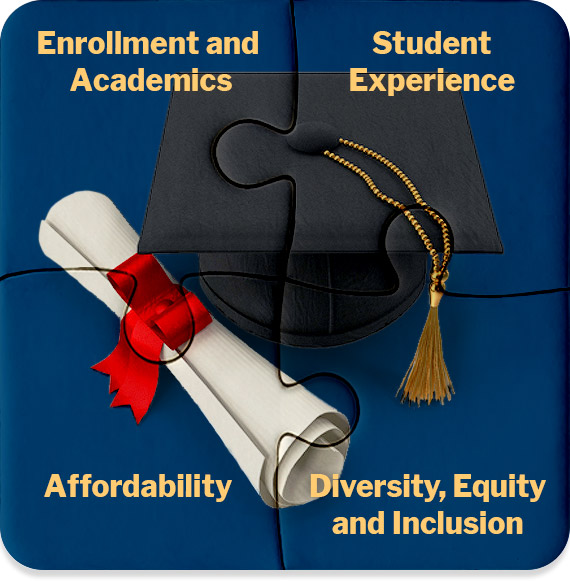
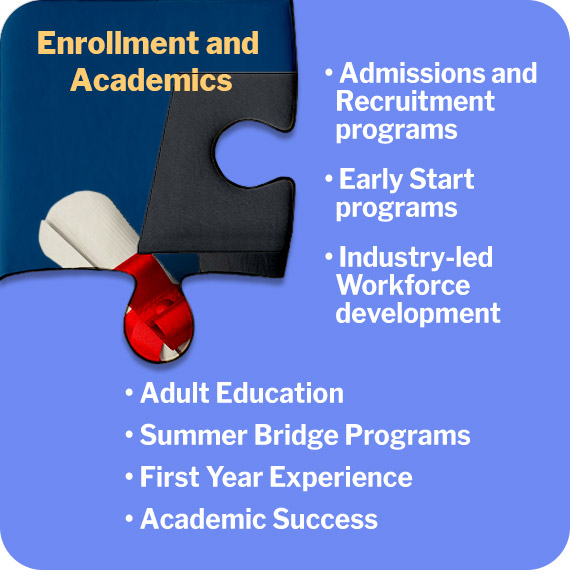


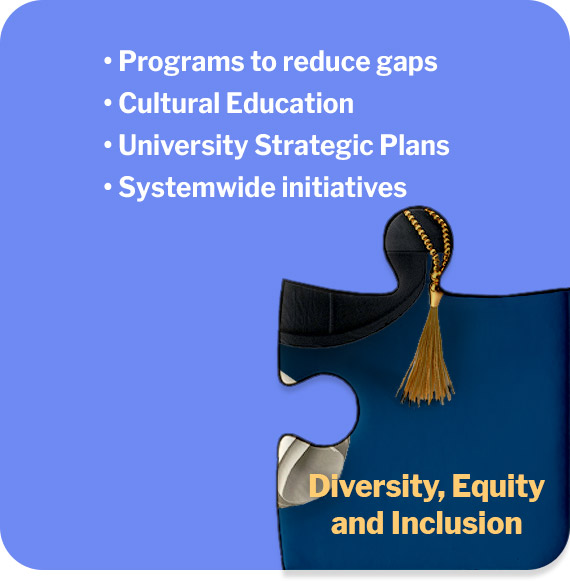
January 2022 Theme: Workforce Alignment
Our universities support economic development across the Commonwealth by preparing and graduating students in high-priority areas and partnering with businesses and industries that fuel our economy. And yet, Pennsylvania has a pressing need for more employees with some form of higher education. The proportion of jobs requiring a college degree is also growing.
To help meet the forecasted workforce needs, the State System must increase the number of individuals with credentials. Here’s how a fully-funded budget request would enable the State System to further increase credentialing productivity, help meet the state’s workforce demand, and boost our state and regional economies:
- A general appropriation increase of 15% (an increase of $72m for a total of $550m to the State System) may result in a 5% increase in enrollment and a corresponding increase in workforce-ready graduates.
- An additional $201m state investment ($2.3k per student) in new direct-to-student aid to State System students may result in an 8% increase in degree attainment.
State System universities provide relevant degrees: Of all State System graduates employed in Pennsylvania three years after graduation, 81% majored in high-priority program areas (based on high-growth occupations).
- Business
- STEM *
- Health
- Education
- Social Sciences
* Science, Technology, Engineering, and Mathematics
State System students are choosing high-demand fields: For more than ten years, the most popular areas of study for State System students have continued to be the high-priority areas of STEM, Business, Education, Health Professions, and Social Sciences.
State System students are more focused than ever: Over the past ten years, the share of students majoring in high-priority areas increased from 71% to 78%.
Most State System graduates stay in Pennsylvania to live, work and support their communities: Three years after graduating, 71% of bachelor’s degree recipients are working in Pennsylvania and have median annual earnings of $54,708—contributing to local and regional economies.
State System universities are providing flexible paths for working adults: In addition to increasing the number of bachelor’s and master’s degree recipients to meet workforce need, the State System’s initiatives to offer stackable credentials, non-credit training, and certifications can help prepare Pennsylvania’s talent. The State System’s #Prepared4PA initiative is an example of a program that brings together employers and educators for successful transitions in the workforce.
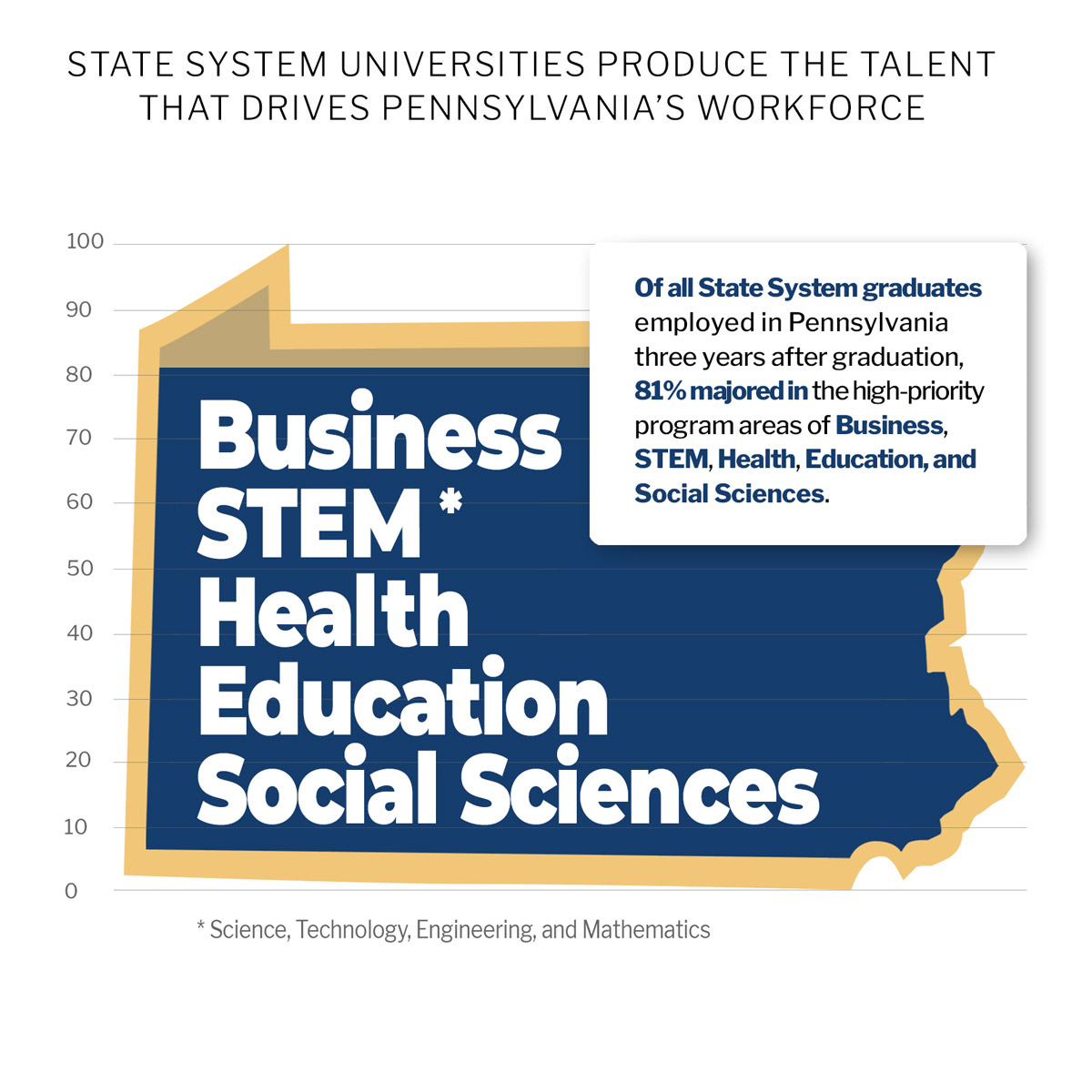
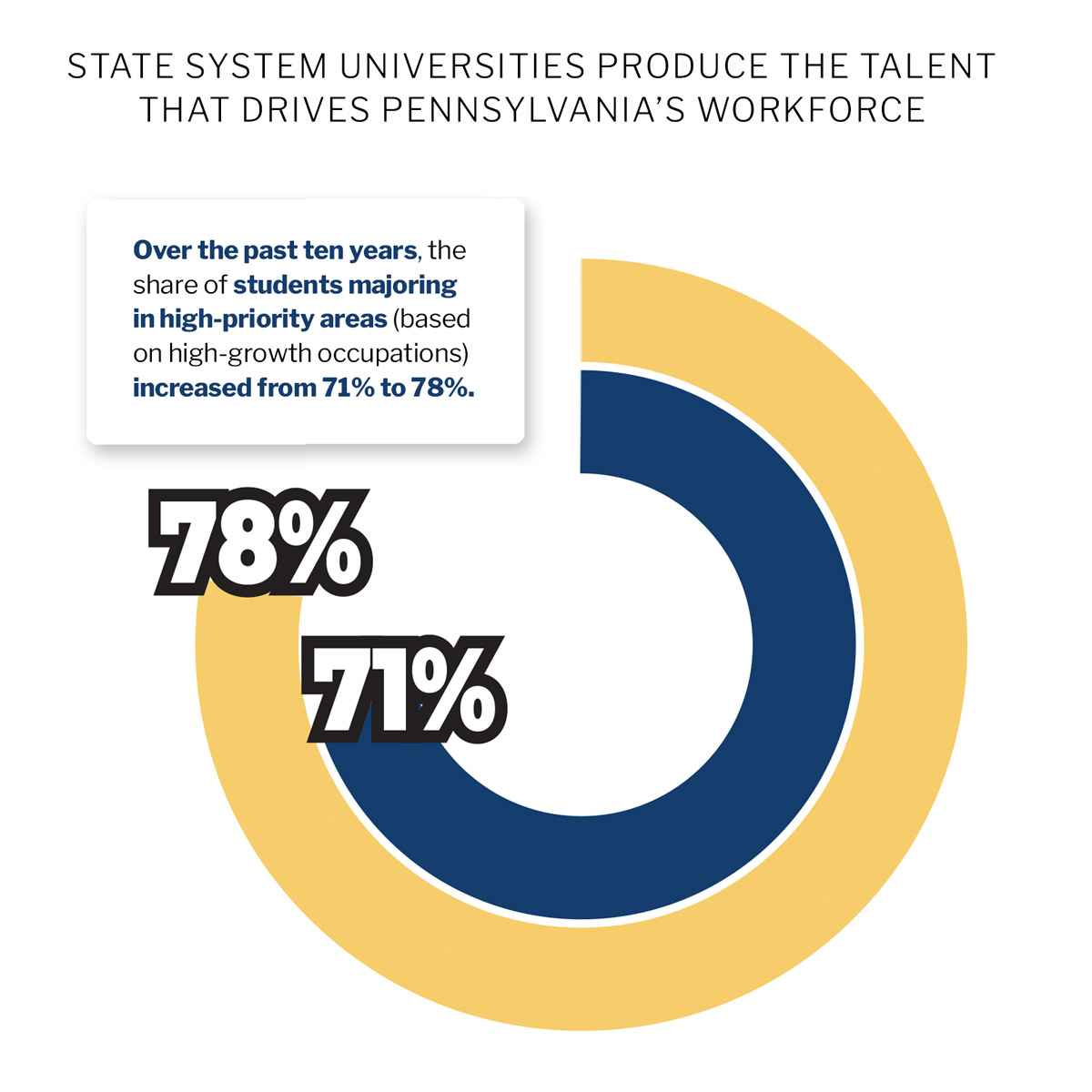
February 2022 Theme: Diversity, Equity, and Inclusion
State System universities are still the most affordable 4-year postsecondary option in Pennsylvania. Ensuring they remain affordable is critical to continuing service to underrepresented minority (URM) students and to meet state social mobility and economic development needs.
A general appropriation of $550 million would enable the State System to expand access and support to URM students who need academic and financial help. The postsecondary success of URM students is critical for Pennsylvania to meet its workforce needs.
Direct-to-student funding of $201 million for State System students could result in an enrollment increase of at least 8% at State System universities. Of those additional 709 students, 134 would be URM students.
The State System and its universities are committed to cultivating diverse, equitable, and inclusive environments that enable all members of the State System community to thrive.
- Since 2015, despite reductions in overall staffing, State System universities have successfully recruited and retained a consistent compliment of URM faculty and staff.
- Five and ten years after graduating, URM students from low-income families are doing as well as white graduates who enrolled as higher-income students.
The State System is committed to ensuring accessibility of all members of its community regardless of one’s identity.
- The 2021 State System Diversity, Equity, and Inclusion Summit brought together more than 500 faculty, students, and staff from across the State System, as well as external researchers and practitioners, to engage in timely discussions around a wide range of DEI topics.
- The State System and its stakeholders identified five
DEI Strategic Priorities that will guide the System’s initiatives over the next five years:
- Faculty, Staff, and Student Diversity
- Equitable Student Outcomes
- Inclusive Communities
- Curriculum Diversity
- Enabling Infrastructures
- The Board of Governors affirmed a systemwide DEI Strategic Framework as a foundation to the State System’s collective work.
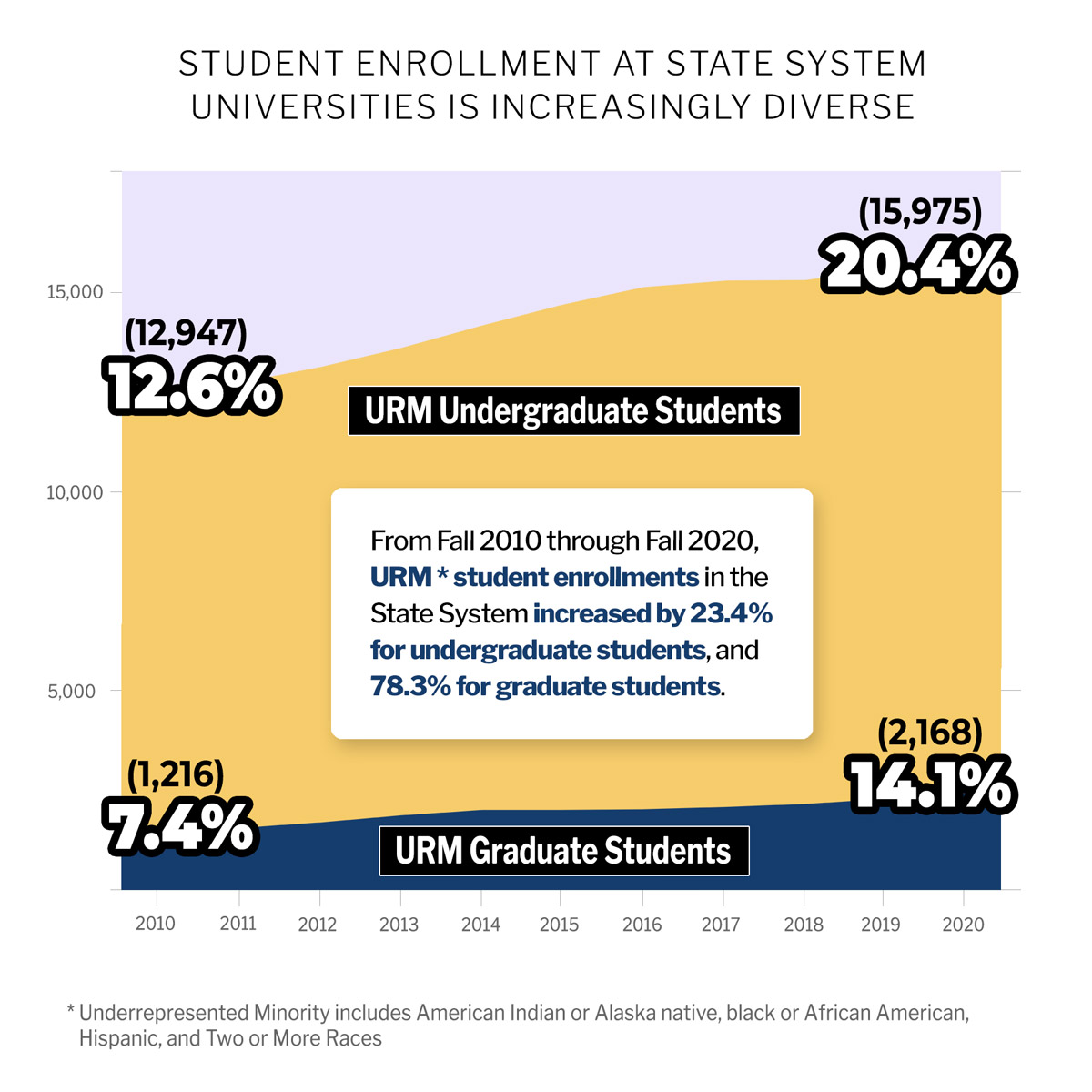
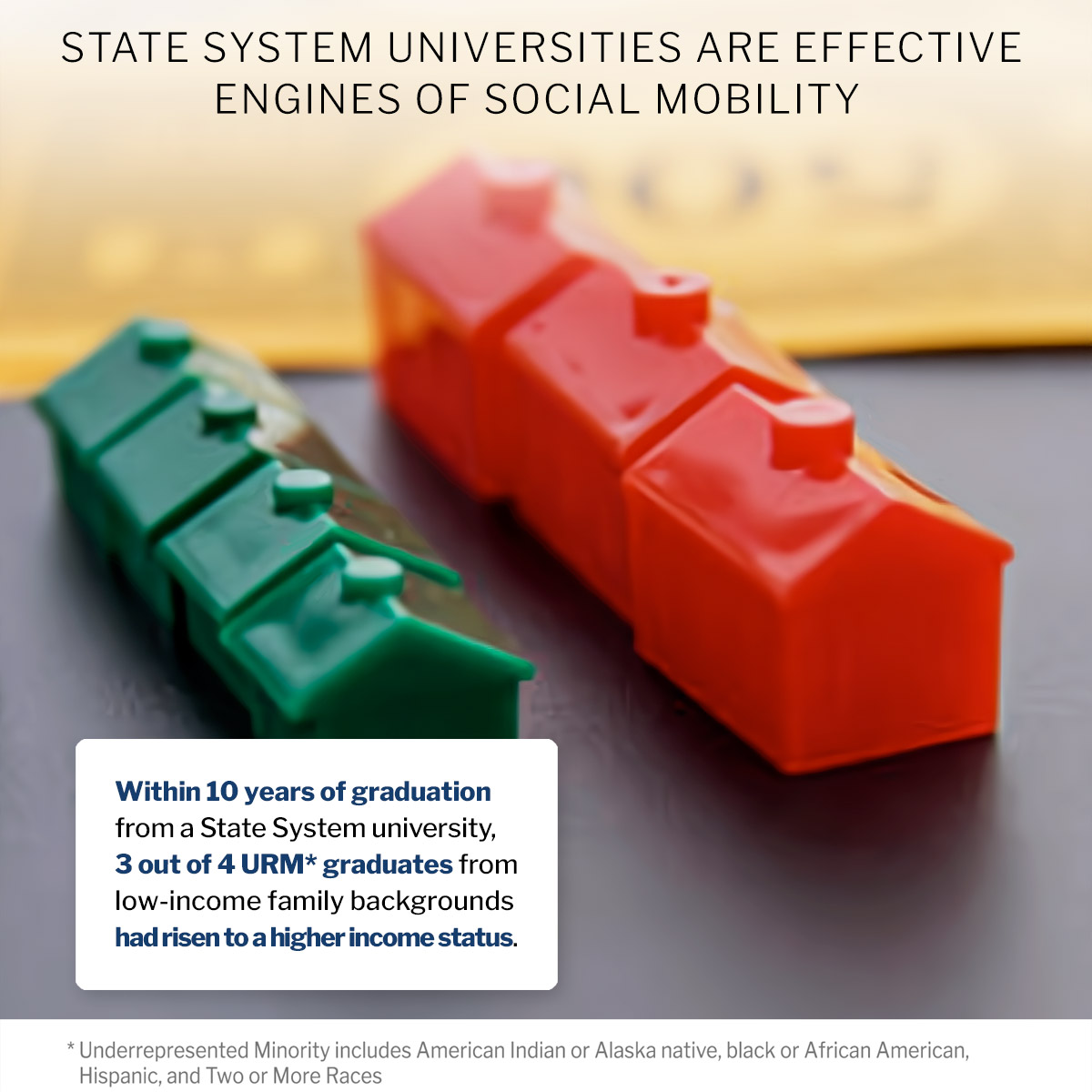
Download JPEG
March 2022 Theme: Student Access and Enrollment
Pennsylvania’s chronic “talent gap” is starving employers of the educated workforce they need to remain competitive. The talent gap can only be filled by improving the higher education achievement level of low and middle-income, underrepresented minority, and adult students.
Declining higher education enrollments worsen the state’s talent gap. Enrollment across the State System has declined 26% since 2010. We estimate about 6% of that is due to the pandemic and another 5% to fewer high school graduates. By far the largest cause is the rising price of attendance.
Significant additional investment is necessary to ensure a State System education is responsive to employers’ needs and accessible to everyone.
State System universities have historically served students of low- and middle-income families who disproportionately rely on financial aid and for whom post-secondary participation is critical to achieving upward mobility.
- 34% of undergraduate students are receiving Pell grants.
- 32% of first-time, degree-seeking undergraduates are first-generation college students.
- 20% of the total enrollment is comprised of underrepresented minority students.
- 70% of in-state undergraduate students are of families with income less than $110,000.
Tuition increases and enrollment declines are negatively correlated to Pennsylvania’s level of public higher education funding.
- The General Assembly’s investment in the State System is down $252 million from 2000-01 in inflation-adjusted dollars.
- The average net price of attending a State System university rose more than 50% in the past decade amid lagging state funding.
- The financial burden borne by students for their State System education was 66% in 2020, up from 47% in 1994.
- Pennsylvania ranks 46th of 50 states in terms of public 4-year educational appropriation per student Full-Time Equivalent.
- Tuition increases have had a larger impact on low- and middle-income students, as evidenced by steeper enrollment declines for those students than for higher-income students.
The State System is hard at work, delivering on its promise to Pennsylvania’s employers as an engine of workforce development.
- State System universities conferred in 2020-21 nearly 24,000 degrees and certificates in high-demand areas like STEM, health, business, and education. (See December Monthly Theme: Student Progression and Completion)
- Dual Enrollment and Early Admit enrollment has doubled since 2016, growing to over 1,000 students. After high school graduation, over 30% of dual enrolled high school students matriculate to a System university and over 35% of early admit students persist at a System university.
- Online enrollments have increased by 18% from 2015-16 to 2019-20. In 2020-21, as a result of the pandemic, over 90% of State System students enrolled in an online course.
- Enrollment in short-term certificate programs (less than 2 years) and nondegree credit-bearing courses has increased by 27% since fall of 2016.
- Degree-seeking students pursuing certificates in conjunction with their degrees has risen since fall of 2016 by over 70%, to over 880 students.
- Fall 2020 and 2021 adult learner enrollments are, proportionately, the highest in State System history, better than the national picture.
Becoming more affordable and helping students achieve their educational goals and dreams has been at the center of everything the State System has done since it began its transformational journey.
- The average amount of institutional aid awarded per student by State System universities has increased 43% since 2017-18.
- Since 2019-20, the average net price has decreased 0.5% while it increased nearly 5% over the prior three years.
- By freezing tuition for three consecutive years, the State System has forgone approximately $63 million in tuition and fee revenue.
- The System’s universities have trimmed nearly $173 million from their operating budgets since 2018, adding to the $400 million in savings achieved in the previous 14 years.
- The Board of Governors approved a Fiscal Year 2022-23 budget request that, if fully funded by the General Assembly, would enable the Board to freeze tuition for a fourth consecutive year. And universities could increase institutional aid by at least 30%, enrollment by at least 8%, and credential production by more than 1,100.
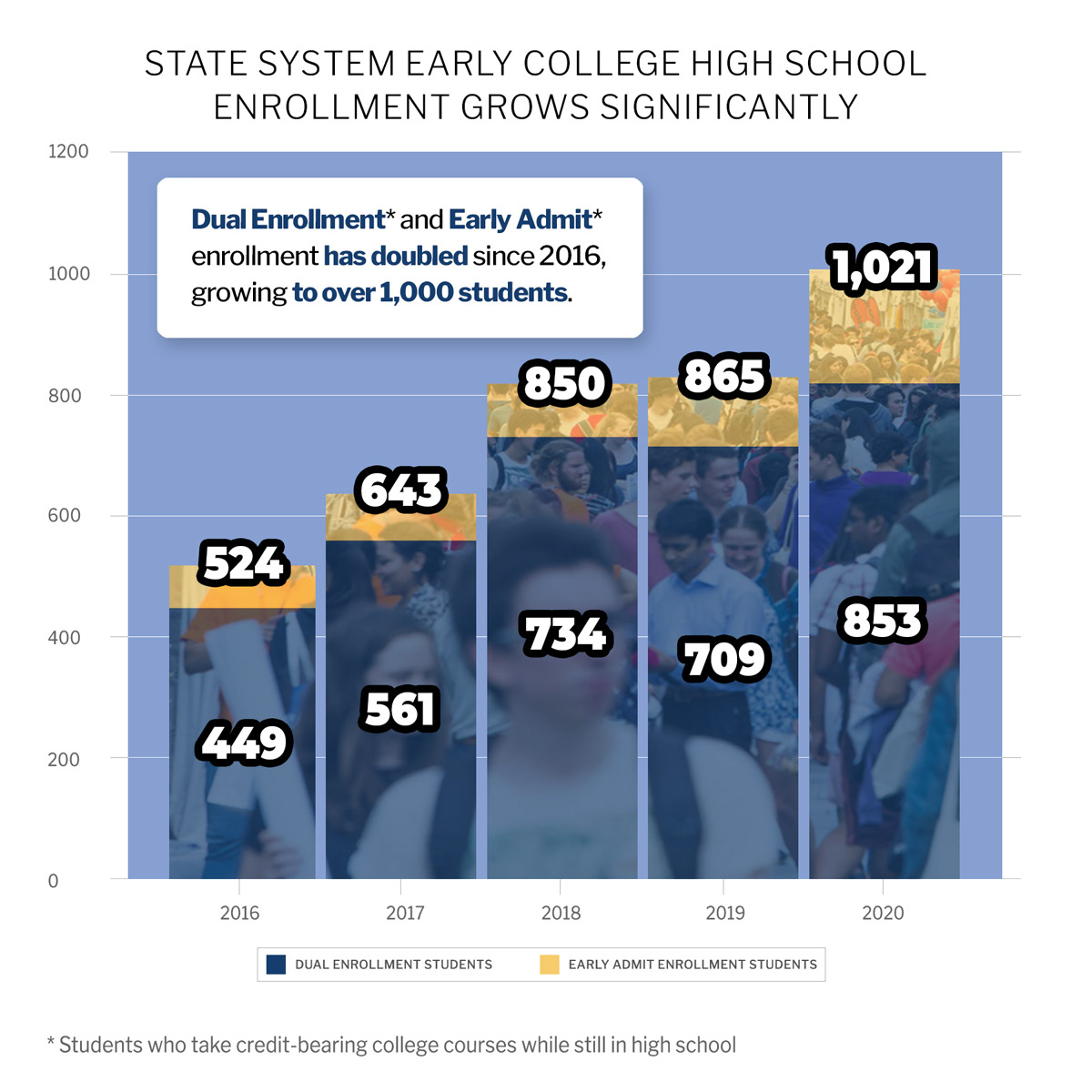
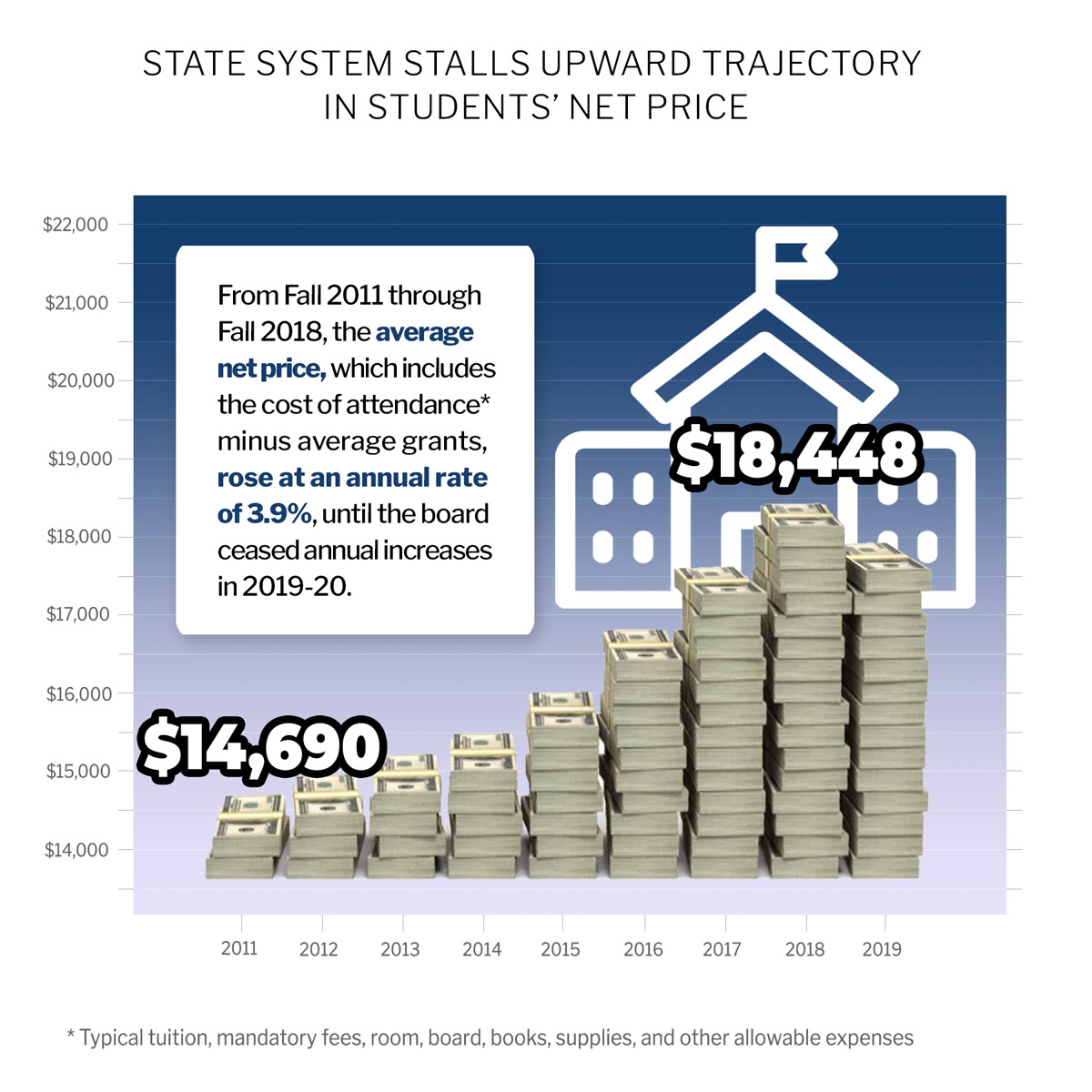
April 2022 Theme: Economic and Social Mobility
The State System delivers value to students by providing opportunities for upward economic and social mobility. The degrees and credentials earned from a State System education help students from low-income families join the middle class and help others to continue climbing the economic ladder. A State System degree catapults graduates to good, family-sustaining jobs. Their higher incomes create economic security for their families, support their local rural or urban communities, and collectively provides a powerful boost to Pennsylvania’s economy.
Education leads to higher wages and improves economic mobility.
Education is a powerful factor for greater income and economic growth. Over their
lifetime, college graduates earn 84% more than those with a high school diploma alone.
On average, workers with a bachelor’s degree earn about $70,000 per year and $2.8
million throughout their career. Each additional education level typically pays off
with higher income jobs throughout a lifetime.
Significant additional investment is necessary to ensure a State System education is responsive to employers’ needs and accessible to everyone.
State System universities are powerful drivers to help Pennsylvanians into the middle class.
- The State System’s high-quality education is aligned to meet the needs of Pennsylvania’s workforce at the lowest possible cost, which drives individual and community economic and social mobility.
- On average, State System graduates earned more than the average high school graduates, regardless of family income, race/ethnicity, program of study, and System university.
- 75% of students from low-income families climb into the middle class within a decade after graduation from a State System university.
- State System graduates earn $866,144 more over their careers than people without a degree.
With significant additional investment in the State System and its students, Pennsylvania can restore and reinvigorate its affordable public higher education option for students, enhance its economic competitiveness, expand opportunities for economic and social mobility, and respond to employers’ urgent need for the talent they need.
Investment in the State System will drive continuing transformational change that is currently underway with the implementation of System Redesign so it is here to serve students, the community, and the Commonwealth for years to come.
